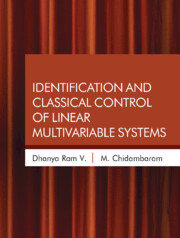Book contents
- Frontmatter
- Contents
- Preface
- Acknowledgements
- List of Abbreviations
- Notations
- 1 Models, Control Theory, and Examples
- 2 Identification and Control of SISO Systems
- 3 Introduction to Linear Multivariable Systems
- 4 CRC Method for Identifying TITO Systems
- 5 CRC Method for Identifying SISO Systems by CSOPTD Models
- 6 CRC Method for Identifying TITO Systems by CSOPTD Models
- 7 Identification of StableMIMO System by Optimization Method
- 8 Identification of Centralized ControlledMultivariable Systems
- 9 Identification of Multivariable SOPTD Models by Optimization Method
- 10 Identification of Unstable TITO Systems by Optimization Technique
- 11 Centralized PI Controllers Based on Steady State Gain Matrix
- 12 SSGM Identification and Control of Unstable Multivariable Systems
- 13 Control of Stable Non-square MIMO Systems
- 14 Control of Unstable Non-square Systems
- 15 Trends in Control ofMultivariable Systems
- Appendix A Identification of Unstable Second Order Transfer Function Model with a Zero by Optimization Method
- Appendix B For Chapter 3
- Appendix C For Chapter 7
- Bibliography
- Index
11 - Centralized PI Controllers Based on Steady State Gain Matrix
Published online by Cambridge University Press: 31 July 2022
- Frontmatter
- Contents
- Preface
- Acknowledgements
- List of Abbreviations
- Notations
- 1 Models, Control Theory, and Examples
- 2 Identification and Control of SISO Systems
- 3 Introduction to Linear Multivariable Systems
- 4 CRC Method for Identifying TITO Systems
- 5 CRC Method for Identifying SISO Systems by CSOPTD Models
- 6 CRC Method for Identifying TITO Systems by CSOPTD Models
- 7 Identification of StableMIMO System by Optimization Method
- 8 Identification of Centralized ControlledMultivariable Systems
- 9 Identification of Multivariable SOPTD Models by Optimization Method
- 10 Identification of Unstable TITO Systems by Optimization Technique
- 11 Centralized PI Controllers Based on Steady State Gain Matrix
- 12 SSGM Identification and Control of Unstable Multivariable Systems
- 13 Control of Stable Non-square MIMO Systems
- 14 Control of Unstable Non-square Systems
- 15 Trends in Control ofMultivariable Systems
- Appendix A Identification of Unstable Second Order Transfer Function Model with a Zero by Optimization Method
- Appendix B For Chapter 3
- Appendix C For Chapter 7
- Bibliography
- Index
Summary
A simple method is given in this chapter to design multivariable Proportional and Integral (PI) and Proportional Integral and Derivative (PID) controllers for stable multivariable systems. The method needs only the Steady State Gain Matrix (SSGM). The method is based on the static decoupler design followed by the SISO PI/PID controllers design and combines the resulting decoupler and the diagonal PI(D) controllers as centralized controllers. The result of the present method is shown to be equivalent to the empirical method proposed by Davison (1976). Three simulation examples have been given in this chapter. The performance of the controllers has been compared with the reported centralized controller based on the multivariable transfer function matrix.
Introduction
Design of PI controllers for stable MIMO processes is difficult when compared to the SISO processes due to the interaction between the input–output variables. As discussed in Chapter 3, the MIMO processes can be controlled by decentralized or decoupled controllers or by centralized PI controllers. For mild interacting stable MIMO processes, design of decentralized PI controllers based on the diagonal processes (based on proper pairing) is carried outwith a suitable detuningmethod. The detuning step involves decreasing the controller gains by F, multiplying integral by F, and decreasing derivative times by F. Here, F is the detuning factor which may vary from 1.5 to 4, depending on the extent of interactions, dictated by the RGA. For systems with large interactions, the decoupler (D) is designed so as to make the MIMO processes into n SISO processes. The PI controllers (Gc) are designed for the resulting SISO processes. The overall control system is the combined decoupler and the diagonal controllers (DGc). We can also design, straight away, the centralized PID controllers. The SSGM of the multivariable system can be obtained more easily than identifying the dynamic model parameters and, hence, it is easier to tune the controllers. In this chapter, derivation of a simple method of designing multivariable PI controllers is explained, based on SSGM of the system.
Multivariable System
The stable multivariable system (Fig. 3.3 in Chapter 3) is assumed to be of the form given in Eq. (11.1).
- Type
- Chapter
- Information
- Publisher: Cambridge University PressPrint publication year: 2023



